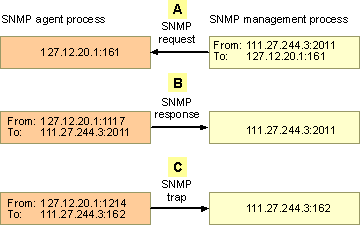 Important: Important: |
|---|
| This is retired content. This content is outdated and is no longer being maintained. It is provided as a courtesy for individuals who are still using these technologies. This content may contain URLs that were valid when originally published, but now link to sites or pages that no longer exist. |


SNMP operations focus on retrieving or modifying the value of management information, and reporting an event. They occur through message exchange over a message transport service. Each SNMP operation has its own type of message. An SNMP message consists of a header and a protocol data unit (PDU) identifying the message type and containing further data necessary to complete the request.
The following table shows the message types that are supported by Windows Embedded CE.
| Message type | Description | From/To |
|---|---|---|
|
GetRequest |
Accesses and retrieves the value of one or more instances of management information. |
Manager/agent |
|
GetNextRequest |
Accesses and retrieves the value of the next instance of management information in lexicographical order. |
Manager/agent |
|
GetBulk |
Accesses multiple values at one time (SNMPv2c only). |
Manager/agent |
|
GetResponse |
Reply to a GetRequest, GetNextRequest, and SetRequestoperation. |
Agent/manager |
|
SetRequest |
Stores and sets a value in a variable. |
Manager/agent |
|
Trap |
An unsolicited message that is sent by an SNMP agent to an SNMP manager and indicates that some event has occurred. |
Agent/manager |
- GetRequest
-
The SNMP manager uses the GetRequestmessage to retrieve data from the managed objects that are maintained by an SNMP agent. By using GetRequest, the manager can request the value of one or more MIB variables, provided that the MIBs that specify the variables are supported by the agent that receives the GetRequestmessage.
- GetNextRequest
-
The GetNextRequestmessage, like the GetRequestmessage, is used by the SNMP service to retrieve data from a managed object that is maintained by an SNMP agent. GetNextRequestand GetRequesthave the same format, but they use different operations. Unlike GetRequest, GetNextRequestdoes not require that the instance identifier of each variable be specified in its OID.
- GetBulk
-
This operation is new for SNMPv2. It allows the SNMP manager to retrieve large amounts of information from the agent without initiating a GetNextRequestoperation.
- SetRequest
-
The SNMP manager uses the SetRequestmessage to request that management data that is maintained by an agent be modified. SetRequesthas the same format as the GetRequestmessage, but it is used to write an object value, not to read one.
- Trap
-
The SNMP service can handle requests and report network management information to one or more hosts in discrete blocks of data that are known as traps. Traps notify a network management device that an extraordinary event has occurred at an agent. When a trap condition occurs, the SNMP agent sends an SNMP-agent trap message to each of the network management stations, as specified in the trap receiver table.
The following illustration shows how messages are exchanged between the SNMP agent and the SNMP service.









 See Also
See Also